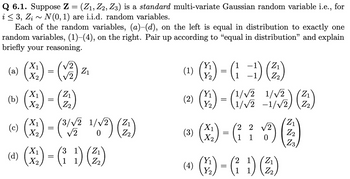
A First Course in Probability (10th Edition)
10th Edition
ISBN: 9780134753119
Author: Sheldon Ross
Publisher: PEARSON
expand_more
expand_more
format_list_bulleted
Question

Transcribed Image Text:Q 6.1. Suppose Z = (Z₁, Z2, Z3) is a standard multi-variate Gaussian random variable i.e., for
i ≤ 3, Zi~ N(0, 1) are i.i.d. random variables.
Each of the random variables, (a)–(d), on the left is equal in distribution to exactly one
random variables, (1)–(4), on the right. Pair up according to "equal in distribution" and explain
briefly your reasoning.
X₁
(a)
X₂
(b) (x₂) - (2)
(c) (x²) - (¹/1² 1/√²) (2₁)
(3/√2
=
√2
=
(V2)
Z₁
(d) (x) - (1) (²)
X2
Y₁
(9)-(-) (2)
(1=1)
Y₂
(1)
Y₁
(²) (4) - (1/²
(3)
(1/√√2
1/√2-1/√2)
(x₁) = (²₁ ² ✓/³²) (3)
2 2 √2
1
Z3
Y₁
→ ()-())
(4)
=
Y₂
1/2) (2)
1)
(2)
Expert Solution
This question has been solved!
Explore an expertly crafted, step-by-step solution for a thorough understanding of key concepts.
Step by stepSolved in 3 steps with 46 images

Knowledge Booster
Similar questions
- 4. In professor Shankar's quiz, the time taken to complete the quiz is a random variable with a pdf £x (x) = 20 = exp(-26 ) ₁ x 20² 20 1₂x ≥0 What is the average time for completion? If there are 50 students in the class, what is the probability that at least 20 of them will complete the quiz in less than the average? What is the probability that exactly 35 students complete within the average time.arrow_forward[8.3]arrow_forwardTime le 15 box A contains 4 red and 5 blue balls and box B contains 6 red and 3 blue balls. A ball is chosen at random from box A and placed in box B. Finally, a ball is chosen at random now from in box B. What is ed d out of the probability a blue ball was transferred from box A to box B given that the ball chosen from box B is red? a question Select one: O a. 0.5 O b. 0.4828 O c. 0.5172 Od. 0.7 revious page Next page DELL REDMI NOTE 9S AI QUAD CAMERA F10 F11 Priscoarrow_forward
- 5. Suppose there are 2 populations, each with mean ₁ and 4₂ and standard deviation of ₁ and 2 respectively. The interest is to measure a random variable X by taking a random sample of size n from the first population. In a similar manner, another random variable Y is measured by independently taking a random sample of size m from the second population. Assuming n and m are sufficiently large, then demonstrate the following properties: a. X~N (μ₁, 1) b. 8~ N(H₂. /) c. (8-8)-№ (1₁ - 1₂ + 15t marrow_forward3.3.24. Let X1, X2 be two independent random variables having gamma distribu- tions with parameters a₁ = 3, B₁ = 3 and a2 = 5, B2 = 1, respectively. (a) Find the mgf of Y = 2X₁ +6X2. (b) What is the distribution of Y?arrow_forwardfor the first part, could u tell me why the lower bound is 0 rather than x? We can see from the question that 0<x<y<1, if u set the lower bound=0, x might be bigger than yarrow_forward
arrow_back_ios
arrow_forward_ios
Recommended textbooks for you
 A First Course in Probability (10th Edition)ProbabilityISBN:9780134753119Author:Sheldon RossPublisher:PEARSON
A First Course in Probability (10th Edition)ProbabilityISBN:9780134753119Author:Sheldon RossPublisher:PEARSON

A First Course in Probability (10th Edition)
Probability
ISBN:9780134753119
Author:Sheldon Ross
Publisher:PEARSON
